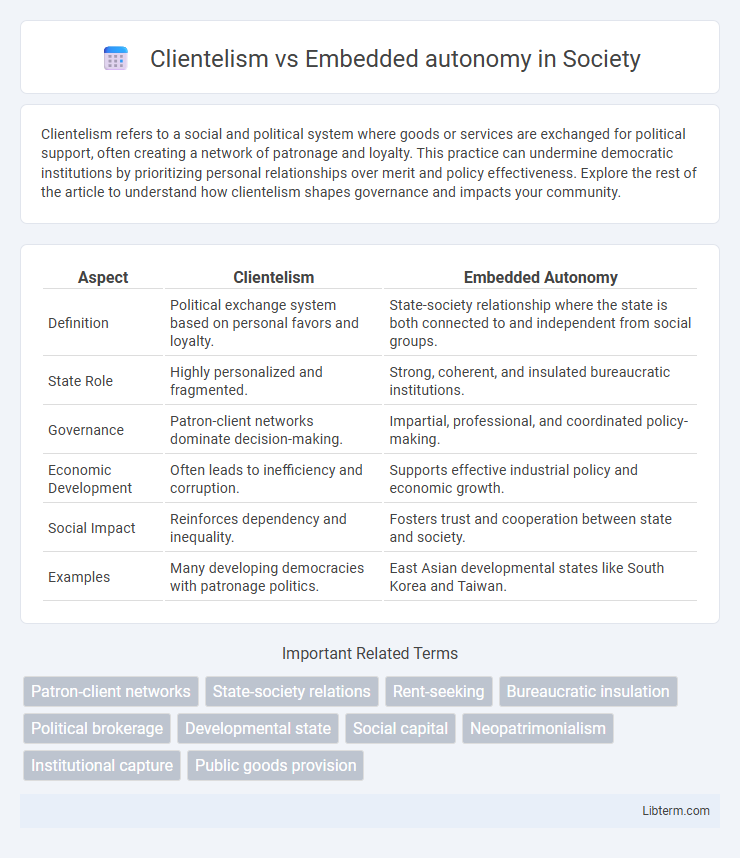Clientelism refers to a social and political system where goods or services are exchanged for political support, often creating a network of patronage and loyalty. This practice can undermine democratic institutions by prioritizing personal relationships over merit and policy effectiveness. Explore the rest of the article to understand how clientelism shapes governance and impacts your community.
Table of Comparison
| Aspect | Clientelism | Embedded Autonomy |
|---|---|---|
| Definition | Political exchange system based on personal favors and loyalty. | State-society relationship where the state is both connected to and independent from social groups. |
| State Role | Highly personalized and fragmented. | Strong, coherent, and insulated bureaucratic institutions. |
| Governance | Patron-client networks dominate decision-making. | Impartial, professional, and coordinated policy-making. |
| Economic Development | Often leads to inefficiency and corruption. | Supports effective industrial policy and economic growth. |
| Social Impact | Reinforces dependency and inequality. | Fosters trust and cooperation between state and society. |
| Examples | Many developing democracies with patronage politics. | East Asian developmental states like South Korea and Taiwan. |
Introduction to Clientelism and Embedded Autonomy
Clientelism refers to a political system where goods and services are exchanged for political support, often characterized by personalized and reciprocal relationships between patrons and clients. Embedded autonomy describes a state structure that maintains strong ties with society while preserving bureaucratic independence, enabling effective policy implementation. Understanding these concepts highlights the tension between personalized political networks and institutional capacity in governance.
Defining Clientelism: Meaning and Characteristics
Clientelism refers to a socio-political system where resources and services are exchanged for political support, often manifesting through personalized networks rather than institutional frameworks. Characterized by asymmetrical relationships, clientelism involves a patron granting benefits to clients in return for loyalty, creating dependency and undermining public meritocracy. Unlike embedded autonomy, which promotes state capacity through institutional ties, clientelism perpetuates fragmentation and limits effective governance by prioritizing particularistic interests.
Understanding Embedded Autonomy: Concept and Features
Embedded autonomy refers to a governance model where state agencies maintain strong ties with social and economic actors while preserving bureaucratic autonomy to formulate and implement policies effectively. This concept balances close collaboration and information exchange with industries and interest groups, enabling the state to drive developmental goals without undue capture or clientelistic influences. Key features include institutional insulation, a professionalized bureaucracy, and strategic engagement with societal sectors that foster innovation and economic transformation.
Historical Context: Evolution of Both Concepts
Clientelism, rooted in patrimonial and patronage systems, evolved from pre-modern social structures where personal relationships dictated political support and resource distribution. Embedded autonomy emerged as a concept in the late 20th century to describe state capacity that balances bureaucratic independence with close ties to societal actors, particularly in East Asian developmental states from the 1960s onward. The historical evolution highlights clientelism's association with personalized, informal networks, contrasting with embedded autonomy's institutionalized, strategic collaboration between state and society for economic development.
Clientelism in Practice: Real-World Examples
Clientelism manifests in various countries as political leaders exchange goods or services for electoral support, often undermining institutional development and perpetuating inequality. Examples include patronage networks in Latin America, where politicians distribute resources to loyal supporters, and similar systems in parts of Africa and South Asia, where clientelist practices influence public service delivery and governance. This contrasts with embedded autonomy models, which emphasize bureaucratic insulation and state capacity to implement policies effectively.
Embedded Autonomy in Governance: Case Studies
Embedded autonomy in governance refers to a state's capacity to pursue development goals through bureaucratic institutions that are both autonomous from particularistic interests and socially embedded within the society. Case studies from countries like South Korea and Taiwan demonstrate how embedded autonomy enabled effective policymaking by balancing strong state intervention with close collaboration with private sectors and civil society. This governance model contrasts with clientelism by promoting institutional mechanisms that reduce patron-client dependencies and foster sustainable economic growth.
Comparing Clientelistic and Autonomous States
Clientelistic states prioritize personalized exchange networks where political support is traded for specific material benefits, often leading to fragmented policy implementation and weak state capacity. Autonomous states demonstrate embedded autonomy by maintaining strong, impartial bureaucracies that balance state interests with societal engagement, enabling coherent and effective governance. This contrast shapes development outcomes, with autonomous states typically achieving higher institutional efficiency and long-term policy stability compared to clientelistic counterparts.
Impacts on Development and Policy Effectiveness
Clientelism obstructs development and policy effectiveness by fostering patronage networks that prioritize short-term gains and personal loyalty over inclusive growth and institutional integrity. Embedded autonomy enhances developmental outcomes by enabling state institutions to maintain strategic independence while engaging collaboratively with social actors, promoting coherent policy implementation and sustained economic progress. The contrast between clientelism's fragmented governance and embedded autonomy's coordinated state capacity critically shapes the quality of development and the effectiveness of public policies.
Challenges and Limitations of Each Approach
Clientelism faces significant challenges such as fostering dependency, undermining institutional development, and perpetuating inequality by exchanging goods or services for political support. Embedded autonomy, while promoting effective state-society collaboration and policy implementation, struggles with maintaining genuine independence from powerful interest groups and risks bureaucratic capture. Both approaches exhibit limitations in scalability and sustainability, as clientelism often leads to fragmented governance and embedded autonomy can be hindered by complex political dynamics and institutional inertia.
Conclusion: Toward Effective State-Society Relations
Effective state-society relations require balancing clientelism, which fosters personal networks and patronage, with embedded autonomy, where bureaucracies maintain independence while engaging civil society. Embedded autonomy supports institutional capacity and policy implementation without overreliance on clientelist exchanges, enhancing governance quality. Achieving sustainable development depends on state actors' ability to navigate societal interests while preserving bureaucratic autonomy and accountability.
Clientelism Infographic

 libterm.com
libterm.com